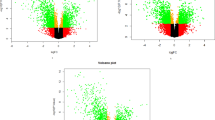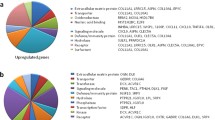Abstract
Breast cancer affects every 1 of 3000 pregnant women or in the first post-partum year is referred as Pregnancy Associated Breast Cancer (PABC) in mid 30s. Even-though rare disease, classified under hormone receptor negative status which metastasis quickly to other parts by extra cellular matrix degradation. Hence it is important to find an optimal treatment option for a PABC patient. Also additional care should be taken to choose the drug; in order to avoid fetal malformation and post-partum stage side-effects. The adaptation of target based therapy in the clinical practice may help to substitute the mastectomy treatment. Recent studies suggested that certain altered Post Translational Modifications (PTMs) may be an indicative of breast cancer progression; an attempt is made to consider the over represented PTM as a parameter for gene selection. The public dataset of PABC from GEO were examined to select Differentially Expressed Genes (DEG). The corresponding PTMs for DEG were collected and association between them was found using data mining technique. Usually clustering algorithm has been applied for the study of gene expression with drawback of clustering of gene products based on specified features. But association rule mining method overcome this shortcoming and determines the useful and in depth relationships. From the association, genes were selected to study the interactions and pathways. These studies emphasis that the genes KLF12, FEN1 MUC1 and SP110, can be chosen as target, which control cancer development, without any harm to pregnancy as well as fetal developmental process.

Similar content being viewed by others
References
Keyser EA, Staat BC, Fausett MB, Shields AD (2012) Pregnancy-associated breast cancer. Rev Obstet Gynecol 5(2):94–99
Jin H, Zangar RC (2009) Protein modifications as potential biomarkers in breast cancer. Biomark Insights 4:191–200
Wang Y-C, Peterson SE, Loring JF (2014) Protein post-translational modifications and regulation of pluripotency in human stem cells. Cell Res 24(2):143–160. doi:10.1038/cr.2013.151
Becquet C, Blachon S, Jeudy B, Boulicaut J-F, Gandrillon O (2002) Strong-association-rule mining for large-scale gene-expression data analysis: a case study on human SAGE data. Genome Biol 3(12) research0067.0061-research0067.0016
Creighton C, Hanash S (2003) Mining gene expression databases for association rules. Bioinformatics (Oxford, England) 19(1):79–86
Seeja KR, Alam MA, Jain SK (2009) An association rule mining Approach for co-regulated Signature genes identification in cancer. J Circ Sys Comp 18(08):1409–1423. doi:10.1142/S0218126609005757
Pugazhendi D (2013) Apriori algorithm on marine fisheries biological data. Int J Comp Sci & Eng Technol 4(12):1409–1411
Harvell DM, Kim J, O'Brien J, Tan AC, Borges VF, Schedin P, Jacobsen BM, Horwitz KB (2013) Genomic signatures of pregnancy-associated breast cancer epithelia and stroma and their regulation by estrogens and progesterone. Horm & cancer 4(3):140–153. doi:10.1007/s12672-013-0136-z
The UniProt C (2012) Reorganizing the protein space at the universal protein resource (UniProt). Nucleic Acids Res 40(D1):D71–D75
Agrawal R, Srikant R (1994) Fast algorithms for mining association rules in large databases. Paper presented at the proceedings of the 20th international conference on very large data bases
Kanehisa M, Goto S, Kawashima S, Nakaya A (2002) The KEGG databases at GenomeNet. Nucleic Acids Res 30(1):42–46
Zuberi K, Franz M, Rodriguez H, Montojo J, Lopes CT, Bader GD, Morris Q (2013) GeneMANIA prediction server 2013 update. Nucleic Acids Res 41(W1):W115–W122
Huang DW, Sherman BT, Tan Q, Kir J, Liu D, Bryant D, Guo Y, Stephens R, Baseler MW, Lane HC, Lempicki RA (2007) DAVID bioinformatics resources: expanded annotation database and novel algorithms to better extract biology from large gene lists. Nucleic Acids Res 35(Web Server issue):W169–W175. doi:10.1093/nar/gkm415
Shannon P, Markiel A, Ozier O, Baliga NS, Wang JT, Ramage D, Amin N, Schwikowski B, Ideker T (2003) Cytoscape: a software environment for integrated models of biomolecular interaction networks. Genome Res 13(11):2498–2504. doi:10.1101/gr.1239303
Freeman LC (1978) Centrality in social networks conceptual clarification. Soc Networks 1(3):215–239. doi:10.1016/0378-8733(78)90021-7
Valente TW, Coronges K, Lakon C, Costenbader E (2008) How correlated are network centrality measures? Connections (Toronto, Ont) 28(1):16–26
Azuaje FJ (2014) Selecting biologically informative genes in co-expression networks with a centrality score. Biol Direct 9:12. doi:10.1186/1745-6150-9-12
Chen HM, Tanaka N, Mitani Y, Oda E, Nozawa H, Chen JZ, Yanai H, Negishi H, Choi MK, Iwasaki T, Yamamoto H, Taniguchi T, Takaoka A (2009) Critical role for constitutive type I interferon signaling in the prevention of cellular transformation. Cancer Sci 100(3):449–456. doi:10.1111/j.1349-7006.2008.01051.x
Golubovskaya VM, Kweh FA, Cance WG (2009) Focal adhesion kinase and cancer. Histol Histopathol 24(4):503–510
McCready J, Arendt LM, Glover E, Iyer V, Briendel JL, Lyle SR, Naber SP, Jay DG, Kuperwasser C (2014) Pregnancy-associated breast cancers are driven by differences in adipose stromal cells present during lactation. Breast Cancer Res : BCR 16(1):R2. doi:10.1186/bcr3594
Russo J, Moral R, Balogh GA, Mailo D, Russo IH (2005) The protective role of pregnancy in breast cancer. Breast Cancer Res : BCR 7(3):131–142. doi:10.1186/bcr1029
Britt K, Ashworth A, Smalley M (2007) Pregnancy and the risk of breast cancer. Endocr Relat Cancer 14(4):907–933. doi:10.1677/erc-07-0137
Anders CK, Johnson R, Litton J, Phillips M, Bleyer A (2009) Breast cancer before age 40 Years. Semin Oncol 36(3):237–249. doi:10.1053/j.seminoncol.2009.03.001
Gabriel CA, Domchek SM (2010) Breast cancer in young women. Breast Cancer Res : BCR 12(5):212–212. doi:10.1186/bcr2647
Pawson T, Scott JD (2005) Protein phosphorylation in signaling – 50 years and counting. Trends Biochem Sci 30(6):286–290. doi:10.1016/j.tibs.2005.04.013
Knutson TP, Daniel AR, Fan D, Silverstein KA, Covington KR, Fuqua SA, Lange CA (2012) Phosphorylated and sumoylation-deficient progesterone receptors drive proliferative gene signatures during breast cancer progression. Breast Cancer Res : BCR 14(3):R95. doi:10.1186/bcr3211
Daniel AR, Faivre EJ, Lange CA (2007) Phosphorylation-dependent antagonism of sumoylation derepresses progesterone receptor action in breast cancer cells. Mol endocrinol (Baltimore, Md) 21(12):2890–2906. doi:10.1210/me.2007-0248
McIlwain DR, Berger T, Mak TW (2013) Caspase functions in cell death and disease. Cold Spring Harb Perspect Biol 5(4):a008656. doi:10.1101/cshperspect.a008656
Elmore S (2007) Apoptosis: a review of programmed cell death. Toxicol Pathol 35(4):495–516. doi:10.1080/01926230701320337
Nakagawa H, Wakabayashi-Nakao K, Tamura A, Toyoda Y, Koshiba S, Ishikawa T (2009) Disruption of N-linked glycosylation enhances ubiquitin-mediated proteasomal degradation of the human ATP-binding cassette transporter ABCG2. FEBS J 276(24):7237–7252. doi:10.1111/j.1742-4658.2009.07423.x
Nakanishi T, Ross DD (2012) Breast cancer resistance protein (BCRP/ABCG2): its role in multidrug resistance and regulation of its gene expression. Chinese J Cancer 31(2):73–99. doi:10.5732/cjc.011.10320
Nakagawa H, Tamura A, Wakabayashi K, Hoshijima K, Komada M, Yoshida T, Kometani S, Matsubara T, Mikuriya K, Ishikawa T (2008) Ubiquitin-mediated proteasomal degradation of non-synonymous SNP variants of human ABC transporter ABCG2. Biochem J 411(3):623–631. doi:10.1042/bj20071229
Zhang MH, Man HT, Zhao XD, Dong NI, Ma SL (2014) Estrogen receptor-positive breast cancer molecular signatures and therapeutic potentials (review). Biomed Rep 2(1):41–52. doi:10.3892/br.2013.187
Schraenen A, de Faudeur G, Thorrez L, Lemaire K, Van Wichelen G, Granvik M, Van Lommel L, in’t Veld P, Schuit F (2010) mRNA expression analysis of cell cycle genes in islets of pregnant mice. Diabetologia 53(12):2579–2588. doi:10.1007/s00125-010-1912-8
Zhang H, Zhu X, Chen J, Jiang Y, Zhang Q, Kong C, Xing J, Ding L, Diao Z, Zhen X, Sun H, Yan G (2015) Kruppel-like factor 12 is a novel negative regulator of forkhead box O1 expression: a potential role in impaired decidualization. Reprod Biol Endocrinol : RB&E 13:80. doi:10.1186/s12958-015-0079-z
Chester N, Kuo F, Kozak C, O’Hara CD, Leder P (1998) Stage-specific apoptosis, developmental delay, and embryonic lethality in mice homozygous for a targeted disruption in the murine Bloom’s syndrome gene. Genes Dev 12(21):3382–3393
Li W, Cornell R (2007) Redundant activities of Tfap2a and Tfap2c are required for neural crest induction and development of other non-neural ectoderm derivatives in zebrafish embryos. Dev Biol 304(1):338–354. doi:10.1016/j.ydbio.2006.12.042
Piccinni SA, Bolcato-Bellemin A-L, Klein A, Yang VW, Kedinger M, Simon-Assmann P, Lefebvre O (2004) Krüppel-like factors regulate the Lama1 Gene encoding the laminin α1 chain. J Biol Chem 279(10):9103–9114. doi:10.1074/jbc.M305804200
Spencer TE, Bazer FW (2004) Uterine and placental factors regulating conceptus growth in domestic animals. J Anim Sci 82(E-Suppl):E4–13
Iwase T, Tanaka M, Suzuki M, Naito Y, Sugimura H, Kino I (1993) Identification of protein-tyrosine kinase genes preferentially expressed in embryo stomach and gastric cancer. Biochem Biophys Res Commun 194(2):698–705. doi:10.1006/bbrc.1993.1878
Hayata T, Blitz IL, Iwata N, Cho KWY (2009) Identification of embryonic pancreatic genes using Xenopus DNA microarrays. Dev Dyn 238(6):1455–1466. doi:10.1002/dvdy.21868
Sewduth RN, Jaspard-Vinassa B, Peghaire C, Guillabert A, Franzl N, Larrieu-Lahargue F, Moreau C, Fruttiger M, Dufourcq P, Couffinhal T, Duplaa C (2014) The ubiquitin ligase PDZRN3 is required for vascular morphogenesis through Wnt/planar cell polarity signalling. Nat Commun 5:4832. doi:10.1038/ncomms5832
De Hertogh R, Ekka E, Vanderheyden I, Glorieux B (1986) Estrogen and progestogen receptors in the implantation sites and interembryonic segments of rat uterus endometrium and myometrium. Endocrinology 119(2):680–684. doi:10.1210/endo-119-2-680
Larsen E, Gran C, Sæther BE, Seeberg E, Klungland A (2003) Proliferation failure and gamma radiation sensitivity of Fen1 null mutant mice at the blastocyst stage. Mol Cell Biol 23(15):5346–5353. doi:10.1128/MCB.23.15.5346-5353.2003
Wang T, Ong P, Roscioli T, Cliffe ST, Church JA (2012) Hepatic veno-occlusive disease with immunodeficiency (VODI): first reported case in the U.S. and identification of a unique mutation in Sp110. Clin Immunol (Orlando, Fla) 145(2):102–107. doi:10.1016/j.clim.2012.07.016
Horm TM, Schroeder JA (2013) MUC1 and metastatic cancer: expression, function and therapeutic targeting. Cell Adhes Migr 7(2):187–198. doi:10.4161/cam.23131
Alam M, Rajabi H, Ahmad R, Jin C, Kufe D (2014) Targeting the MUC1-C oncoprotein inhibits self-renewal capacity of breast cancer cells. Oncotarget 5(9):2622–2634. doi:10.18632/oncotarget.1848
Uhlen M, Bjorling E, Agaton C, Szigyarto CA, Amini B, Andersen E, Andersson AC, Angelidou P, Asplund A, Asplund C, Berglund L, Bergstrom K, Brumer H, Cerjan D, Ekstrom M, Elobeid A, Eriksson C, Fagerberg L, Falk R, Fall J, Forsberg M, Bjorklund MG, Gumbel K, Halimi A, Hallin I, Hamsten C, Hansson M, Hedhammar M, Hercules G, Kampf C, Larsson K, Lindskog M, Lodewyckx W, Lund J, Lundeberg J, Magnusson K, Malm E, Nilsson P, Odling J, Oksvold P, Olsson I, Oster E, Ottosson J, Paavilainen L, Persson A, Rimini R, Rockberg J, Runeson M, Sivertsson A, Skollermo A, Steen J, Stenvall M, Sterky F, Stromberg S, Sundberg M, Tegel H, Tourle S, Wahlund E, Walden A, Wan J, Wernerus H, Westberg J, Wester K, Wrethagen U, Xu LL, Hober S, Ponten F (2005) A human protein atlas for normal and cancer tissues based on antibody proteomics. Mol Cell Proteomics : MCP 4(12):1920–1932. doi:10.1074/mcp.M500279-MCP200
Uhlen M, Oksvold P, Fagerberg L, Lundberg E, Jonasson K, Forsberg M, Zwahlen M, Kampf C, Wester K, Hober S, Wernerus H, Bjorling L, Ponten F (2010) Towards a knowledge-based human protein atlas. Nat Biotechnol 28(12):1248–1250. doi:10.1038/nbt1210-1248
Ponten F, Jirstrom K, Uhlen M (2008) The human protein atlas--a tool for pathology. J Pathol 216(4):387–393. doi:10.1002/path.2440
Acknowledgment
We thank Pranitha Jenardhanan, Manivel Panneerselvam and Kannan Muthu for their valuable suggestions.
Support and Funding
This work was carried out in Centre for Bioinformatics, Pondicherry University under the UGC funded project.
Author information
Authors and Affiliations
Corresponding author
Ethics declarations
Competing Interests
The authors declare that they have no competing interests.
Authors’ Contributions
RT designed the study, performed the analysis and wrote the manuscript. AV, NL contributed to critical review of the manuscript. All authors read and approved the final manuscript.
Rights and permissions
About this article
Cite this article
Thanmalagan, R.R., Naorem, L.D. & Venkatesan, A. Expression Data Analysis for the Identification of Potential Biomarker of Pregnancy Associated Breast Cancer. Pathol. Oncol. Res. 23, 537–544 (2017). https://doi.org/10.1007/s12253-016-0133-y
Received:
Accepted:
Published:
Issue Date:
DOI: https://doi.org/10.1007/s12253-016-0133-y




